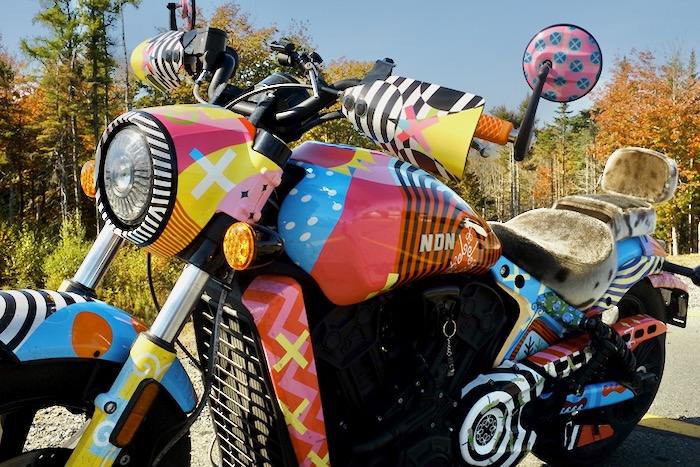It’s no great mystery that motorcycling is more dangerous than driving a car. According to the Société de l’assurance automobile du Québec (SAAQ), although motorcycles make up only three per cent of the vehicles on La Belle Province’s roads (and, then, only for half the year), they accounted for 16% of all Quebec traffic fatalities in 2013. An Australian study almost duplicated the numbers. Ditto the U.S. Department of Transportation’s data. The fact is, we are over-represented in fatal road accidents. And it’s getting worse: While cars — thanks to airbags and a plethora of electronic safety aids — are becoming safer, motorcycle fatalities have, in recent years, remained fairly steady. In 1994, motorcyclists represented 5% of all American traffic deaths. In 2012, that number was 14%.
Those lopsided statistics are partially explained by a motorcycle’s lack of protective bodywork and energy-absorbing air bags. Only one two-wheeler, Honda’s Gold Wing, has a supplemental restraint air bag, and other manufacturers don’t seem to be in a hurry to copy Honda’s lead. Minor crashes that might crumple a fender and bruise a knee in an automobile can have serious consequences. Factor in (let’s call it) youthful enthusiasm that is not conducive to CAA-approved safe motoring and the fact that alcohol is an even greater contributor to single two-wheel-vehicle accidents, and motorcyclists are behind the eight-ball right from the get-go.
Nonetheless, the truth remains — and statistics from around the globe bear this out — that we are most in danger from other motorists. The root of the problem is known to all: Drivers simply do not see motorcycles. “I did not see him” remains the most common explanation for otherwise conscientious motorists plowing into unsuspecting motorcyclists—fully “69% of the other vehicle drivers attempted no collision avoidance manoeuvre” according to a 2000 European study, suggesting, said the Motorcycle Accidents In-Depth Study, that they simply did not see the motorcycle before they struck it.
It’s why so many motorcyclists wear high-visibility neon clothing (I’m pretty sure that my prized new Schuberth E1 can be seen from outer space). It’s why motorcycles have had daytime running lights longer than cars and it’s why we — or maybe that’s just I — flash our high beams as we approach intersections. Nonetheless, It would seem to be all for naught as nearly half of all motorcycle-car collisions result from car drivers “not seeing” or “not seeing in time” a motorcyclist at an intersection.
But, what if we could make it so every car driver could see us? Or, if not actually “see” us, at least be indubitably, incontrovertibly aware that we, well, exist and, more specifically, that we’re existing in a space they need to share.
It’s called vehicle-to-vehicle communication (V2V in the acronyms that computer geeks love so) and it will almost assuredly be the greatest safety boon to motorcycles since the full-face helmet.
Essentially, V2V allows all cars — and, more importantly, motorcycles — to communicate directly with each other. Using something called Dedicated Short Range Communication (DSRC) — essentially a short-range version of WiFi — vehicles can literally tell where each other is and, more impressively, can actually predict what that other vehicle might be about to do.
For instance, since a car’s brake system is computer connected, a V2V-equipped motorcycle would know that some schmuck is about to run a red light because his car communicated that he hasn’t even touched the brake pedal and he’s about to blow though the intersection at 60 per. In another scenario altogether too common, your V2V system might alert you that the bonehead indicating a left turn across your path hasn’t seen you. Because his car transmitted information to your motorcycle that a) his flashers are on, and b) he has taken his foot off the brake and moved it over to the gas pedal, it knows — in the most common of all car-motorcycle collisions — that he’s just about to pull out right in front of you. Indeed, think of all the times you haven’t been seen. Now imagine them all eliminated.
But how would we get all this information relayed to us?
Well, the short-term solution might be audible alerts through the Bluetooth communications systems we all seem to be mounting in our helmets these days. Helmets with head-up displays — like the so-far stillborn Skully AR-1 — would prove even more useful, the projection also able to tell us where the danger is. The most likely solution, however, is to have all the V2V information projected — as automotive head-up displays do — onto our windscreens. Samsung is developing a Smart Windscreen capable of projecting all manner of information — from our cellphones, V2V systems, etc. — onto our windshields in a less distracting, more comprehensible fashion than face-shield systems.
Nor is this — like fully autonomous automobiles — a flight of future fancy. Cadillac and Mercedes-Benz will have 2017 models in showrooms soon with full V2V communications systems. More importantly, BMW, Honda and Yamaha have joined forces to develop a cooperative-intelligent transportation system (C-ITS) for motorcycles, the precursor to full V2V communications systems for two-wheelers.
And just because you’re not buying a new bike doesn’t mean you can’t benefit from this safety revolution. Aftermarket systems will be fairly cheap and easy to install. For instance, retrofitted systems might not be able to warn you what the other drivers are doing, but they will be able to flash your lights — saving me the tribulation of toggling my Hi/Lo beam at every intersection — when it detects a car that’s ignoring your space. More importantly, even if they have nothing but transmit functions, at least they will alert car drivers to your presence.
Yes, car drivers will actually “see” you. Which is a whole helluva lot more than we can say now.






